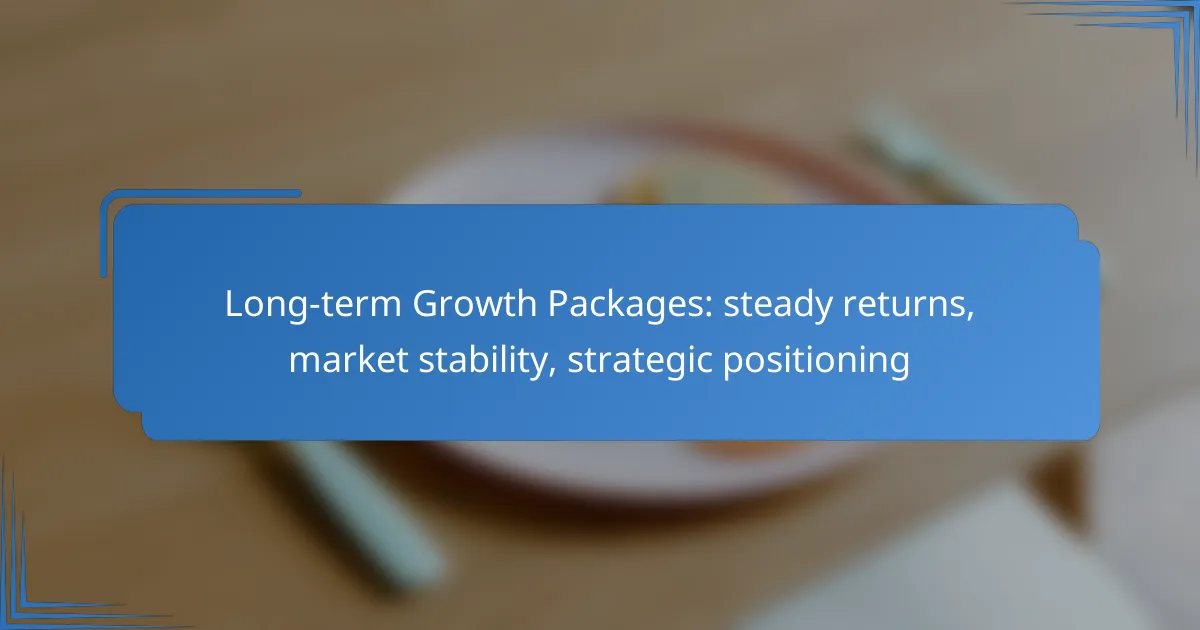Long-term growth packages offer investors a strategic approach to wealth accumulation by combining diverse investment options such as balanced portfolios, index funds, and real estate investment trusts. These packages are crafted to deliver steady returns while ensuring market stability, allowing for consistent income and capital appreciation over time. By understanding the underlying economic indicators and market trends, investors can make informed decisions that align with their financial goals.

What are the best long-term growth packages in Australia?
The best long-term growth packages in Australia typically include balanced investment portfolios, index funds, real estate investment trusts (REITs), managed funds, and superannuation options. These packages are designed to provide steady returns, market stability, and strategic positioning for investors looking to grow their wealth over time.
Balanced investment portfolios
Balanced investment portfolios combine various asset classes, such as stocks, bonds, and cash, to minimize risk while aiming for steady returns. This diversification helps to cushion against market volatility and can lead to more stable growth over the long term.
When constructing a balanced portfolio, consider allocating around 60% to equities and 40% to fixed income, adjusting based on your risk tolerance and investment horizon. Regularly rebalancing your portfolio is crucial to maintain your desired asset allocation.
Index funds
Index funds are investment funds that aim to replicate the performance of a specific market index, such as the ASX 200 in Australia. They offer a low-cost way to gain exposure to a broad range of companies, making them ideal for long-term growth.
Investors should look for index funds with low management fees, typically around 0.1% to 0.5%, to maximize returns. A buy-and-hold strategy is often recommended, as it allows investors to benefit from the compounding effect over time.
Real estate investment trusts
Real estate investment trusts (REITs) allow investors to gain exposure to the real estate market without directly owning property. They invest in income-generating real estate and distribute a significant portion of their earnings as dividends, making them attractive for long-term growth.
Investors should consider the type of REITs, such as residential, commercial, or industrial, based on their risk appetite and market conditions. A well-diversified REIT portfolio can provide both capital appreciation and regular income.
Managed funds
Managed funds pool money from multiple investors to invest in a diversified portfolio of assets, managed by professional fund managers. These funds can focus on various strategies, including growth, income, or balanced approaches, catering to different investor needs.
When selecting a managed fund, examine the fund’s historical performance, fees, and the manager’s track record. It’s essential to understand the investment strategy and ensure it aligns with your long-term financial goals.
Superannuation options
Superannuation is a retirement savings scheme in Australia, designed to help individuals save for their retirement. Contributing to superannuation funds can provide tax advantages and long-term growth potential through various investment options.
Consider choosing a super fund that offers a diversified investment strategy, including shares, property, and fixed interest, to optimize growth. Regular contributions and understanding the fees associated with your super fund can significantly impact your retirement savings over time.

How do long-term growth packages ensure steady returns?
Long-term growth packages are designed to provide steady returns through a combination of consistent income and capital appreciation. By investing in a diversified portfolio, these packages aim to minimize risks while maximizing potential gains over time.
Consistent dividend payouts
Consistent dividend payouts are a key feature of long-term growth packages, offering regular income to investors. Companies with a strong history of dividend payments often provide a reliable cash flow, which can be reinvested or used for other expenses.
Investors should look for companies with a track record of increasing dividends annually, as this indicates financial health and a commitment to returning value to shareholders. A typical range for dividend yields might be between 2% and 5%, depending on the sector and market conditions.
Capital appreciation
Capital appreciation refers to the increase in the value of investments over time, which is a primary goal of long-term growth packages. This growth can stem from rising stock prices, real estate values, or other asset classes.
Investors should focus on assets with strong fundamentals and growth potential, such as technology or healthcare sectors. Historically, equities have provided average annual returns in the range of 7% to 10%, making them a popular choice for long-term growth strategies.
Risk diversification
Risk diversification is crucial in long-term growth packages, as it helps to spread potential losses across various investments. By holding a mix of asset classes, such as stocks, bonds, and real estate, investors can reduce the impact of poor performance in any single area.
A well-diversified portfolio might include 60% equities, 30% fixed income, and 10% alternative investments. This approach not only stabilizes returns but also enhances the potential for growth, making it essential for long-term investors to consider diversification strategies.

What factors contribute to market stability in growth packages?
Market stability in growth packages is influenced by various factors, including economic indicators, the regulatory environment, and market trends analysis. Understanding these elements can help investors make informed decisions and achieve steady returns.
Economic indicators
Economic indicators such as GDP growth, unemployment rates, and inflation levels play a crucial role in assessing market stability. A stable economy typically shows consistent GDP growth and low unemployment, which can lead to increased consumer spending and business investment.
Investors should monitor key indicators like the Consumer Price Index (CPI) and the Producer Price Index (PPI) to gauge inflation trends. A moderate inflation rate, generally around 2-3%, is often considered healthy for economic growth.
Regulatory environment
The regulatory environment significantly impacts market stability by influencing business operations and investor confidence. Clear and consistent regulations can foster a stable investment climate, while sudden changes or uncertainty can lead to volatility.
Investors should stay informed about relevant regulations in their market, such as tax policies, labor laws, and environmental regulations. For example, countries in the European Union have specific regulations that can affect growth packages, making it essential to understand local compliance requirements.
Market trends analysis
Market trends analysis involves examining historical data and current market conditions to predict future movements. Identifying trends in consumer behavior, technological advancements, and industry shifts can provide insights into potential growth opportunities.
Utilizing tools like SWOT analysis (Strengths, Weaknesses, Opportunities, Threats) can help investors evaluate the stability of growth packages. Regularly reviewing market reports and forecasts can also aid in making strategic decisions that align with emerging trends.

How to strategically position long-term growth packages?
Strategically positioning long-term growth packages involves identifying the right mix of assets, implementing effective risk management, and leveraging market insights. This approach ensures steady returns and stability in fluctuating markets.
Targeted asset allocation
Targeted asset allocation is crucial for maximizing returns while managing risk. This involves distributing investments across various asset classes such as equities, bonds, and real estate based on your financial goals and risk tolerance. A common strategy is to allocate a higher percentage to equities for growth and a smaller portion to bonds for stability.
For example, a conservative investor might choose a 60-40 split between stocks and bonds, while a more aggressive investor could opt for 80-20. Regularly reviewing and adjusting this allocation in response to market changes is essential to maintain alignment with your objectives.
Risk management strategies
Effective risk management strategies help protect your investments from significant losses. Diversification is a key tactic, spreading investments across different sectors and asset types to mitigate risks associated with any single investment. Additionally, setting stop-loss orders can limit potential losses by automatically selling assets when they reach a certain price.
Consider using hedging techniques, such as options or futures, to safeguard against market downturns. Regularly assessing your portfolio’s risk exposure and making adjustments can further enhance your long-term growth strategy.
Market research insights
Market research insights provide valuable information that can guide your investment decisions. Analyzing economic indicators, industry trends, and consumer behavior helps identify sectors poised for growth. Tools like SWOT analysis (Strengths, Weaknesses, Opportunities, Threats) can clarify potential investment opportunities and risks.
Staying informed about regulatory changes and market dynamics is also vital. Utilizing resources such as financial news, investment reports, and expert analyses can enhance your understanding of market conditions, allowing for more informed strategic positioning of your growth packages.

What are the key criteria for selecting a long-term growth package?
When selecting a long-term growth package, focus on alignment with your investment goals, the performance history of the package, and the fees and expenses involved. These criteria help ensure that the package meets your financial objectives while providing a clear understanding of potential returns and costs.
Investment goals alignment
Aligning a long-term growth package with your investment goals is crucial for achieving desired outcomes. Consider whether you are targeting capital appreciation, income generation, or a combination of both. For instance, if your goal is to save for retirement, a package focused on steady growth and lower volatility may be more suitable.
Evaluate your risk tolerance as well. A conservative investor may prefer packages that prioritize stability, while an aggressive investor might seek higher potential returns, even with increased risk. Understanding your personal financial situation will guide you in selecting the right package.
Performance history
The performance history of a long-term growth package provides insights into its reliability and potential future returns. Look for packages with a consistent track record over multiple market cycles, ideally spanning several years. A history of steady returns can indicate resilience during market fluctuations.
Examine key performance metrics, such as annualized returns, volatility, and drawdowns. Comparing these metrics against relevant benchmarks can help you assess how well the package has performed relative to the market. Remember, past performance is not a guarantee of future results, but it can serve as a useful indicator.
Fees and expenses
Understanding the fees and expenses associated with a long-term growth package is essential for evaluating its overall value. Common fees include management fees, performance fees, and transaction costs. These costs can significantly impact your net returns over time, so it’s important to choose packages with reasonable fee structures.
As a rule of thumb, aim for total fees that do not exceed 1% to 2% of assets under management. Lower fees can enhance your overall investment returns, especially in a long-term context. Always read the fine print and ask for clarification on any fees that may not be immediately apparent.
